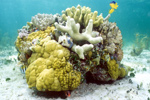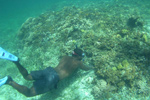
Despite its extraordinary value, the marine environment faces myriad threats from local to global sources. The world's oceans encompass about three quarters of the earth's surface. In addition to supporting critical natural processes, oceanic resources are important for maintaining human economies, amenities, and cultures along the world's coastlines. For example, oceans play a key role in climate regulation, harbor a substantial amount of the planet's biodiversity (especially in coral reefs), and host fisheries, tourism, and shipping industrial sectors.
Marine organisms and habitats are under intense stress, which has resulted in worldwide biodiversity loss (Agardy 2000a). Systems are strained principally by unsustainable fishing practices, as well as other factors such as habitat degradation, coastal development, and climate change (Jackson et al. 2001, Pauly et al. 2002). These factors impact not only the marine environment, but humans as well. Many of the world's commercial fisheries are currently overexploited. World fisheries landings have been slowly declining since the late 1980s, by about 0.7 million tons per year (Pauly et al. 2002). Importantly, fishery operations typically have targeted large, long-lived predatory fishes. With the depletion of these top predators, fisheries have shifted their focus to organisms lower on the food web. This phenomenon, known as "fishing down food webs", may lead to fishery collapses and negative cascading effects that alter the entire system (Pauly et al. 2002). Overexploitation degrades fish stocks and ultimately threatens food security in coastal populations.
There are different ways to address these issues, ranging from single-species to ecosystems-based fishery or biodiversity management. Traditional fishery management has focused on Maximum Sustainable Yield (MSY), calculated for target stocks using population dynamic models (Agardy 2006). This can be employed to determine harvest restrictions, such as size/age limits, quotas, restrictions on numbers of boats, maximum harvest and gear limits, and closures. By setting a size limit above which organisms can be harvested, younger members of the population are protected. Quotas set a maximum limit to capture, which may be essential in curbing efficient fishery operations capable of harvesting above sustainable levels. Closed seasons may ban fishing during times key to organismal life cycles. In parts of the Nassau Grouper range, for example, fishing is prohibited during spawning season to prevent the detrimental effects discussed previously (Sadovy 2002). Traditional measures alone, however, are insufficient to counter the hazards mentioned above (Pauly et al. 2002, Botsford et al. 1997). Management based on MSY, for example, may suffer from uncertainty, imperfect models, insufficient data, and inadequate consideration of ecosystem effects (Stergiou 2002, Pauly et al. 2002). Improved technology and the open-access nature of the sea further contribute to resource depletion.
Marine protected areas (MPAs) are a promising tool for sustaining ocean ecosystems through biodiversity conservation and fishery enhancement (Agardy and Staub 2006, and references therein). MPAs embody a precautionary and ecosystems-based approach to marine management. They protect biodiversity from genes to ecosystems by safeguarding vital processes. An increase in diversity, density, biomass, and size of organisms within marine reserves has been demonstrated in areas protected from resource extraction and habitat damage. This may lead to increased reproduction, as older individuals often make greater reproductive contributions. Closed areas may enhance fisheries by increasing the size and abundance of important target species, replenishing fished areas. The term "spillover" refers to increased production outside reserve boundaries attributed to emigration from within the MPA (Agardy and Staub 2006, and references therein). MPAs also present a solution for management difficulties in working with species of vastly different life histories (Roberts 1997a). Further, they provide a safety valve against inherent uncertainty (Roberts 1997a).
Use of MPAs or reserves alone, however, may be insufficient to protect target stocks from overexploitation (Agardy and Staub 2006). These areas, for example, are often not as large as the focal species home range. In addition, the ecology and life history of many organisms remain insufficiently understood. Chances of success for marine reserves to protect target groups may be greater if managed adaptively, in combination with other conventional methods. Of note, reserves designed to protect focal taxa may not result in ecosystem conservation. Ecosystem-based fisheries management is a promising means of addressing this limitation. This approach focuses on interactions among multiple species and habitats used throughout their life cycles. This strategy recognizes that marine elements are not isolated, and that changes may affect the whole system. The greatest benefits to fishers and biodiversity may accrue from participatory approaches involving multiple stake-holders (Villa et al. 2002).
Written with Camila Sibata, Columbia University.
REFERENCES
Agardy, T. 2000a. Effects of fisheries on marine ecosystems: a conservationist's perspective. ICES J. of Marine Science 57: 761-765.
Agardy, T. 2006. Marine Conservation Biology. NCEP module synthesis document. Available from http://ncep.amnh.org/
Agardy, T. and F. Staub. 2006. Marine Protected Areas and MPA Networks. NCEP module synthesis document. Available from http://ncep.amnh.org/
Botsford, L.W., J.C. Castilla, and C.H. Peterson. 1997. The Management of Fisheries and Marine Ecosystems. Science 277: 509-515.
Jackson, J.B.C, M.X. Kirby, W.H. Berger, K.A. Bjorndal, L.W. Botsford, B.J. Bourque, R.H. Bradbury, R. Cooke, J. Erlandson, J.A. Estes, T.P. Hughes, S. Kidwell, C.B. Lange, H.S. Lenihan, J.M. Pandolfi, C.H. Peterson, R.S. Steneck, M.J. Tegner and R.R. Warner. 2001. Historical overfishing and the recent collapse of ocean ecosystems. Science 293: 629-638.
Pauly, D., V. Christensen, S. Guénette, T.J. Pitcher, U.R. Sumaila, C.J. Walters, R. Watson and D. Zeller. 2002. Towards sustainability in world fisheries. Nature 418: 689-695.
Sadovy, Y. 2002. The Nassau Grouper: A Cautionary Tale of Discovery, Science and Management. Available in part from www.scrfa.org/server/spawning/doc/Grouper.pdf
Stergiou, K.I. 2002. Overfishing, tropicalization of fish stocks, uncertainty and ecosystem management: resharpening Ockham's razor. Fisheries Research 55: 1-9.
Villa, F., L. Tunesi and T. Agardy. 2002. Zoning Marine Protected Areas through Spatial Multiple-Criteria Analysis: the Case of the Asinara Island National Marine Reserve of Italy. Conservation Biology 16 (2), 515-526.






